For a complete tutorial, check out my post on How to Butcher a Chicken. Read my instructions on How to Skin a Chicken!
Plucking Vs Skinning Your Poultry
I’ve noticed that there are two camps when it comes to removing the feathers from your home butchered poultry. Some folks are adamant about scalding and plucking their birds, while others feel it’s a waste of time and it’s better to remove the skin entirely.
I’ve used both methods and each one has pros and cons. Knowing how to do both comes in handy depending on the circumstances.
This page contains affiliate links. You will not pay any extra when you purchase products through these links, but I will receive a small commission. Thank you for supporting The Self Sufficient HomeAcre!

Pros and Cons of Plucking
Advantages:
- You save the skin. Cooking a chicken with the skin produces a juicier bird.
- Less waste and more nutrients gleaned from your home raised poultry.
- Feed the skin to your pets or chickens if you don’t want it.
- Goes pretty quickly once you get the hang of it.
- Scalding and plucking is good for butchering multiple birds.
- Keeping skin on helps prevent freezer burn on meat. (You may remove freezer burned skin prior to cooking.)
- Fat isn’t wasted.
Disadvantages:
- Scalding pot takes a while to heat up.
- You’ll need an outdoor outlet and electric burner, or a propane burner, to heat pot.
- Cleaning up pin feathers and feather shafts from carcass can be time consuming.
Note: A poultry plucker will speed up the process…if you have a lot of birds to pluck you might be interested in a professional style plucker. You may be able to rent it out to help pay for the expense. A more economical option is a drill attachment plucker.
Pros and Cons of Skinning
Advantages:
- Some people don’t like to eat the skin.
- Less fat in cooked meat.
- May be faster, once you practice.
- No picking feather shafts from skin.
- Good for when you butcher only one or two birds.
- Don’t need to preheat scalding pot or have special burner.
- May be easier for ducks, especially older ones that are harder to pluck.
Disadvantages:
- Wastes the skin and fat.
- Difficult to remove skin from wings.
- Bits of feather fluff tend to stick to meat and are hard to clean off.
- Meat is more likely to freezer burn in storage. Use vacuum seal or shrink wrap bags.
Which Method is Right for You?
I’ll leave that decision up to you. You may wish to try both methods. Who knows, you might want to keep both options open. For me, both methods have their place on my homestead.
When Do I Skin My Poultry?
When I make the decision to butcher quickly, I usually skin the bird. For example, if one of my birds is injured or sick (but still edible) I have to do an ’emergency butcher’ session. This must be done swiftly, leaving little time to heat up a scalding pot. I just sharpen my knife, grab a pot, and get to work so the bird doesn’t suffer.
You can pluck a duck more easily with duck wax…
As an Amazon Associate, I earn a commission from qualifying purchases.
Other times I will decide, last minute, to butcher a couple of old stewing hens. Maybe the weather breaks, giving me a chance to process in temps above freezing. Quite often I have a lot of other plans for the day too, and heating up a scalding pot doesn’t fit into my busy schedule. If I need to butcher older ducks (more than 8 weeks of age), I prefer to skin them rather than plucking, because the down is so difficult to remove. I skin the birds on these occasions and get the chore out of the way.
When Do I Pluck My Poultry?
If I’ve been planning a butcher session in advance and I have a few (or many) birds going in the freezer, I take the extra time to get my scalding pot ready. This might be a day when I process a batch of meat birds, or maybe a bunch of my old laying hens needs to make way for youngsters. Sometimes I have a group of young cockerels that are ready for processing. In these cases, I find it easier to scald and pluck the batch rather than skin each one.
Nothing is Set in Stone
And, of course, there are no set rules on my homestead when it comes to skinning vs plucking. If I have the time and inclination, I’ll get the scalding pot out to pluck a couple of old laying hens. You just gotta go with whatever works best for you.

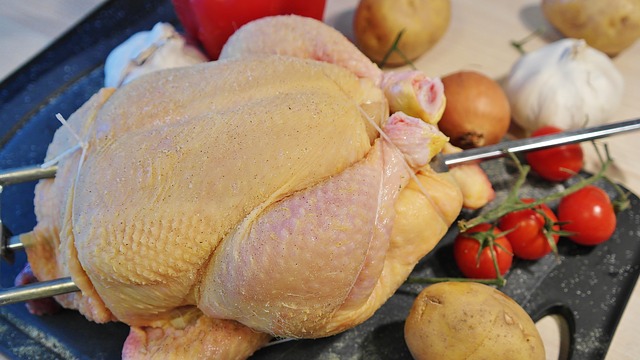
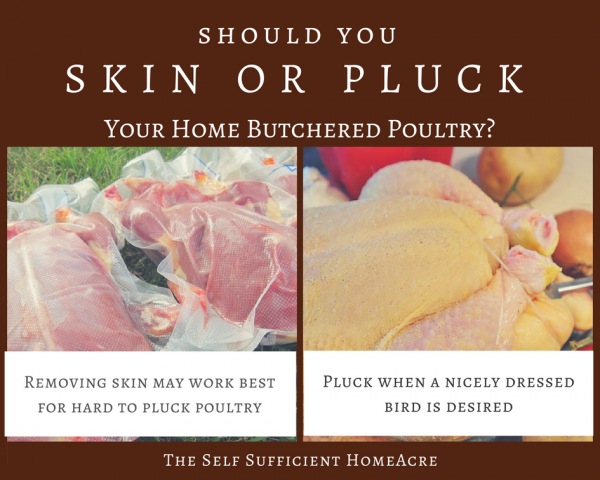
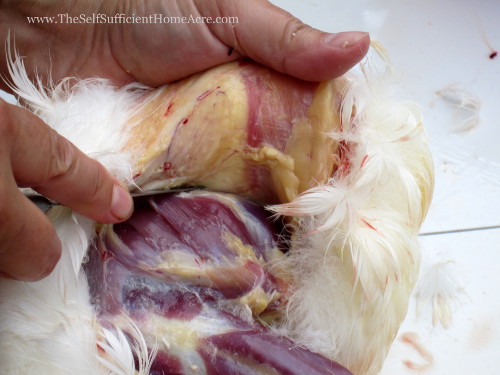

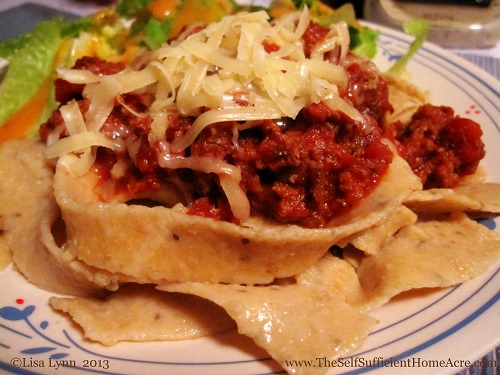
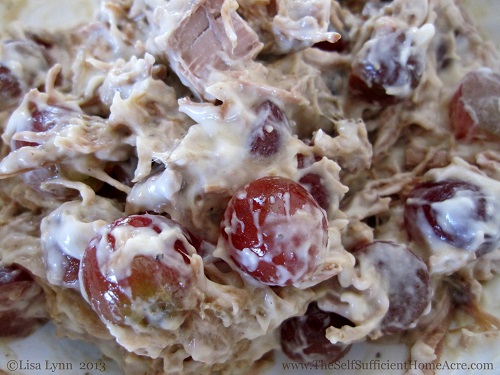
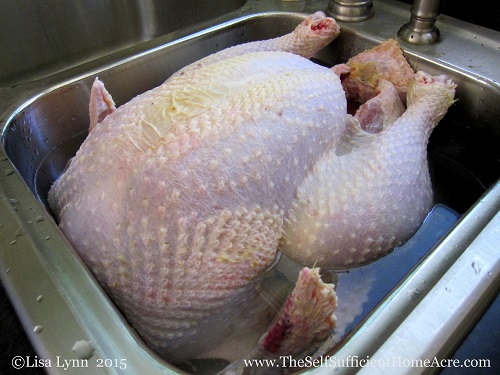
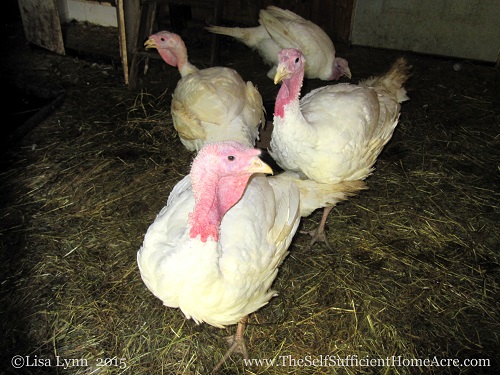
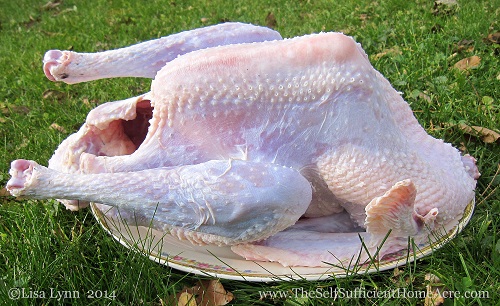

Indy as in Indianapolis. Lol central Illinois just seems like it would be closer. Of course that’s cause I missed the NORTH part lol. Yeah Googling it looks like I’m a good 4.5 hours away from ya. Oh well maybe I will be able to find someone closer who will let me help with the slaughter so I can learn. I don’t know that I could do the actual killing but I’m not too squeamish about anything else. If I do hit the intestines is the meat totally ruined??
Yes…that makes a huge difference! No worries 🙂 I hope you find someone to learn from. I didn’t know if I could kill an animal, then I had a rabbit that had to be put down and was suffering. I couldn’t let her continue to suffer, so I did what I had to do. Killing chickens is much easier than rabbits!
I have gotten the contents of the intestines on the meat a number of times. I rinsed the carcass thoroughly, then dipped in a mild bleach solution, then rinsed again really well. I also make sure to cook the meat until it reached 180 F and I’ve never had any issues. So no, it isn’t ruined. But it’s best if you can avoid it.
Let me know if you get a chance to help with a butcher session! You can also read my tutorial on How to Butcher a Chicken…I walk you through the whole process. I find that chopping a chicken’s head off with a hatchet is very quick.
When you Butcher in batches, do you kill them all at once, then scald them all, then pluck etc or do you do one at a time?
Hi Kayla,
It depends. If there are several people working on the project (not typical, it’s usually just me) we set up an assembly line so there is a bird at each step of the process. Usually I kill the bird and process it, then go on to the next one. This is mainly because I am trying to get the bird from kill to cleaned and chilling as quickly as I can…this prevents rigor mortis from setting in and reduces the growth of bacteria on the carcass.
Good question!
Thanks for letting me know. Where are you in IL? Would it be possible for me to maybe if we got to know each other, come help with a butchering so I can learn?
I’m also breeding a sex link wyandotte sussex cross next year for a good dual purpose bird that should still dress out well fairly young but also be a great layer. I’d be happy to give you some!
I live in the north central part of Illinois…about 20 minutes or so from Rockford. And I’m always happy to teach people how to butcher their own poultry. 🙂
I’m interested in hearing more about your cross breeding project…it’s always interesting to see what people come up with! I’m thinking about downsizing the number of chickens I am keeping, but somehow I always end up with more to take their place. Funny how that works out. 😉
Well I’m breeding a blue laced red roo to a light sussex. The hens should be incomplete blue or black laced red and the roos will be incomplete blue or black laced yellow. The roos can be grown out for slaughter and the hens should lay really well, but should still be a decent size for slaughtering pretty quickly.
I’m in indy so let me know when your next slaughter is and I will try to get there.
They sound beautiful! Indy, as in Indiana? Wow…that’s a long way to go. From our house to Gary, IN is around 3 hours.
I think I will be butchering an old hen tomorrow. 🙂 I’ve had her in the side room of my coop for 4 days and no eggs.
We want to butcher a couple turkeys and make turkey burger, they are old birds, do we have to add some fat to the ground meat, if so should it be beef or pork fat
Hi Pat,
I think I would like the flavor of pork fat better, personally. But maybe you could try a small amount of each and see which you like best? Let me know how your project goes!
This is wonderful information! Thank you so much! My husband and I were JUST talking about how we should approach this issue.
Hi Cris,
So glad that I could be of some help! Check back tomorrow…I’m getting a post ready on how to skin a chicken. 🙂
Have a great day!
This has been my first year with chickens and we culled out 6 roos in the fall. We used the traditional method of scalding and plucking. We have five roos left and one of them is overly agressive but I feel stupid heating up the pot for one bird. Skinning might just be the way to stop the terror. He also attacked my nephew so it is past time for him to go. Thanks for the article.
Hi Charlotte,
Yes, a rooster that starts attacking children is a good candidate for the soup pot! Let me know what you think about the difference between skinning and plucking! Thanks for sharing!